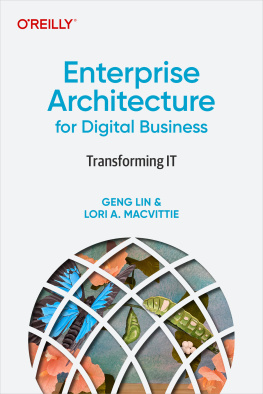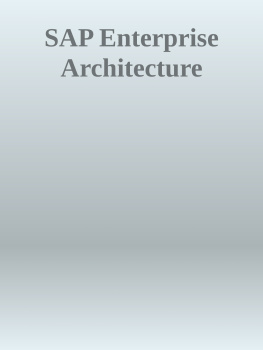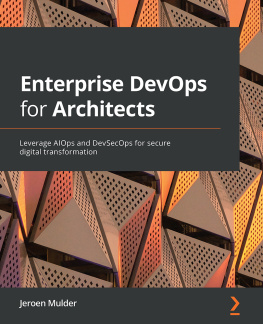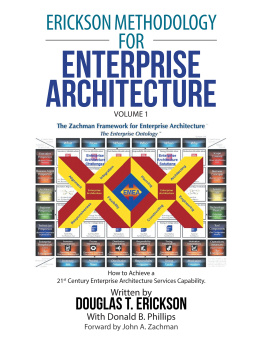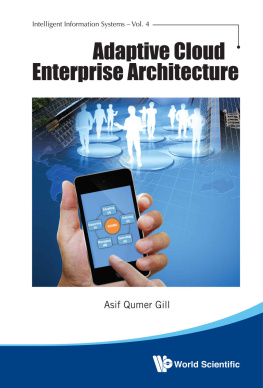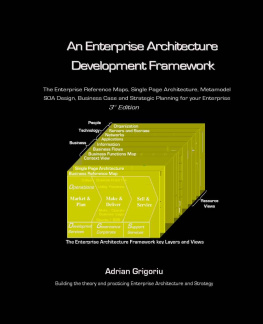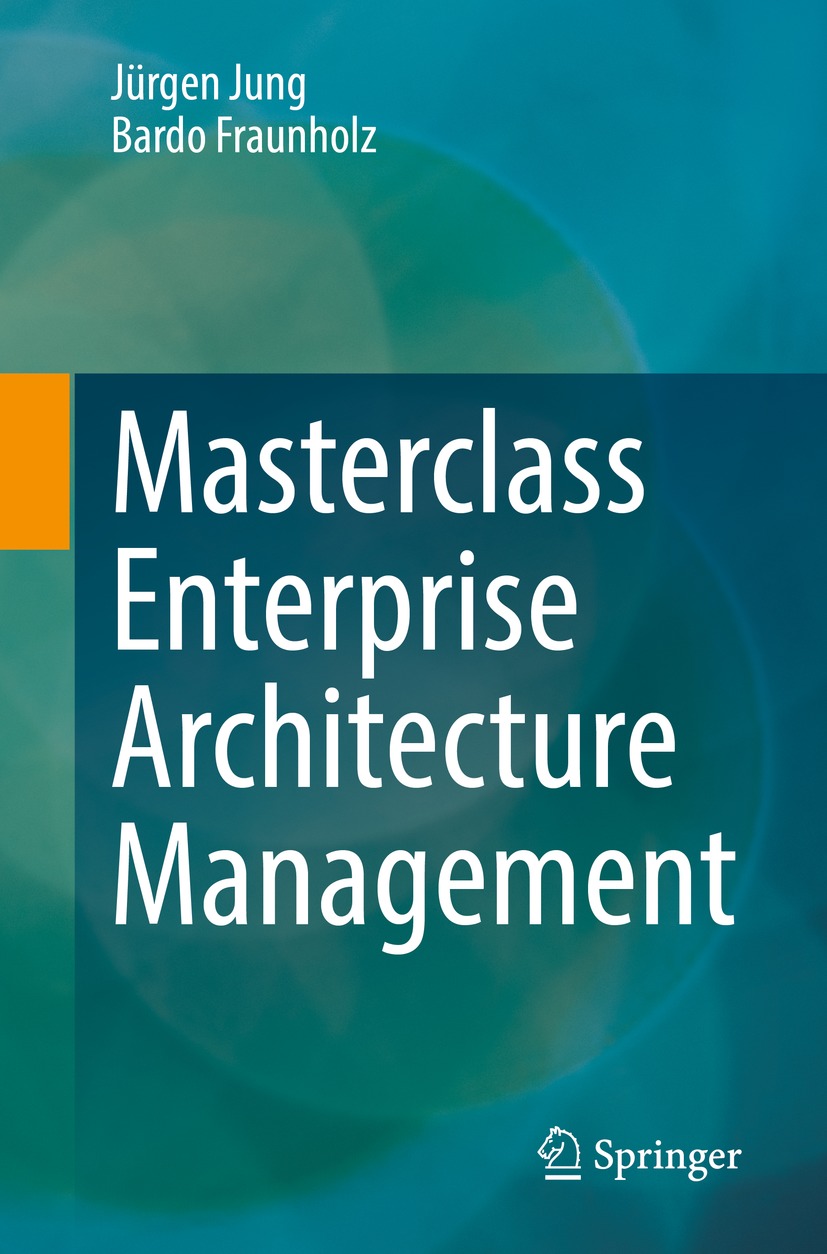Jrgen Jung and Bardo Fraunholz
Masterclass Enterprise Architecture Management
1st ed. 2021

Logo of the publisher
Jrgen Jung
Frankfurt University of Applied Sciences, Frankfurt am Main, Germany
Bardo Fraunholz
Deakin University, Burwood, VIC, Australia
ISBN 978-3-030-78494-2 e-ISBN 978-3-030-78495-9
https://doi.org/10.1007/978-3-030-78495-9
The Editor(s) (if applicable) and The Author(s), under exclusive license to Springer Nature Switzerland AG 2021
This work is subject to copyright. All rights are solely and exclusively licensed by the Publisher, whether the whole or part of the material is concerned, specifically the rights of translation, reprinting, reuse of illustrations, recitation, broadcasting, reproduction on microfilms or in any other physical way, and transmission or information storage and retrieval, electronic adaptation, computer software, or by similar or dissimilar methodology now known or hereafter developed.
The use of general descriptive names, registered names, trademarks, service marks, etc. in this publication does not imply, even in the absence of a specific statement, that such names are exempt from the relevant protective laws and regulations and therefore free for general use.
The publisher, the authors and the editors are safe to assume that the advice and information in this book are believed to be true and accurate at the date of publication. Neither the publisher nor the authors or the editors give a warranty, expressed or implied, with respect to the material contained herein or for any errors or omissions that may have been made. The publisher remains neutral with regard to jurisdictional claims in published maps and institutional affiliations.
This Springer imprint is published by the registered company Springer Nature Switzerland AG
The registered company address is: Gewerbestrasse 11, 6330 Cham, Switzerland
Preface
Enterprise Architecture (EA) originated as a discipline to provide a view of an organisation in order to improve business-IT alignment. Enterprise Architecture evolved beyond business-IT alignment to a more holistic perspective to support organisations in meeting their current and future objectives. Enterprise Architecture is widely understood as visualising inherent structures of an organisation. Enterprise Architecture Management is a management approach that deals with planning and driving the corporate (digital) transformation.
Our personal Enterprise Architecture journey began in the year 2000 when we started to conduct university research in the field of Enterprise Modeling. While Bardo pursued an academic career as a professor at Deakin University (Melbourne, AU), Jrgen was following a career in industry as Enterprise Architect with Deutsche Post DHL in Germany. We maintained contact and continued our joint academic interest in Information Systems. Jrgen returned to academia in 2017 as Professor for Enterprise Architecture Management at the Frankfurt University of Applied Sciences. This academic reunion led to the joint introduction of Enterprise Architecture in both universities as part of the postgraduate Information Systems curriculum.
The textbook at hand originated from lecture notes from both courses. Based on these experiences, lecture recordings and transcripts as well as a script for Enterprise Architecture management, Bardo and Jrgen identified the need for a hands-on introduction to the topic. It is our teaching philosophy that Enterprise Architecture Management is best learned by sharing experiences and guiding students through the applications of methods and tools to typical business problems. The book is intended as a guide to conduct a Masterclass for Enterprise Architecture Management.
The structure of the book represents the typical stages of the journey of an Enterprise Architect. First, we address the central question for an Enterprise Architecture initiative in Chap. : What do we want to achieve with the introduction of Enterprise Architecture? Enterprise Architecture Management is about providing value to an organisation instead of simply applying a method or tool.
Chapter introduces concepts and visualisations for Business Architecture that help with understanding the business. Proven concepts like business capabilities and business objects are used as simple but powerful tools. These concepts cover a functional perspective on the business (business capabilities) together with a view on static entities (business objects). These are complemented by concepts to describe business motivation and business models.
A business capability map is used as a starting point for deriving an application landscape (as presented in Chap. ). Software applications are the counterpart to business capabilities as they implement desired functionality. In the same way, business objects reflect a high-level picture on data objects maintained by business software. Applications and data objects describe corporate information systems.
Business and Application Architecture are rather descriptive, providing transparency on information systems and their business context. They also provide the information required to analyse and improve the application landscape. Enterprise architects are using several visual tools to identify optimisation potential as depicted in Chap.. We introduce the business support matrix that is used to identify typical concerns in the application landscape.
A company is subject to frequent changes driven by changing business requirements and objectives. Such changes must be managed properly and require a corresponding organisational unit. Traditional organisational forms follow a top-down approachi.e. Enterprise Architecture Management is driven by top management. Recent experiences show that a more collaborative Enterprise Architecture Management approach is required. This discussion is presented in Chap..
We do not want to publish a textbook on Enterprise Architecture frameworks. However, frameworks are still relevant for any enterprise architect. Established frameworks are introduced in Chap..
We hope that you enjoy the Enterprise Architecture journey with us!
Jrgen Jung
Bardo Fraunholz
Frankfurt, Germany Burwood, VIC, Australia
April 2021
Acknowledgements
The authors acknowledge The Open Group for permission to include text/figures derived from its copyrighted source
https://pubs.opengroup.org/architecture/togaf92-doc/arch/ .
TOGAFis a registered trademark of The Open Group in the United States and other countries.
The authors acknowledge John A. Zachman and Zachman International, Inc. for permission to include text/figures derived from their copyrighted source. The Zachman Framework for Enterprise Architecture is a registered trademark of John A. Zachman and Zachman International, Inc. www.zachman.com .
Acronyms
AA
Application Architecture
AsPac
Asia/Pacific
ADM
Architecture Development Method
APM
Application Portfolio Management
BA
Business Architecture
BO
Business Object



